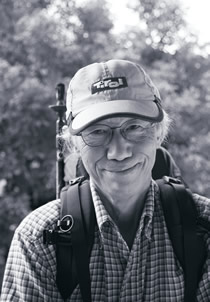Scientist Library
Looking at plants, asking plants
| 1934: | Born in Tokyo |
|---|---|
| 1956: | Graduated from the University of Tokyo with a degree in biology |
| 1961: | Received a doctorate in biology from the University of Tokyo |
| 1961: | Assistant at the Botanical Gardens, Graduate School of Science, The University of Tokyo |
| 1974: | Associate professor in the Faculty of Science at Tokyo Metropolitan University |
| 1981: | Professor in the Faculty of Science at Osaka University |
| 1996: | Professor in the Graduate School of Science at Osaka University |
| 1997: | Visiting professor at The University of California, Davis |
| Awards |
|
|---|


This photo is of me in high school in the garden of our home (municipally-owned housing). At right is my record of observations over two years in high school. I made a careless spelling error in the title.
When I was a junior high school student, I asked my teacher why there were holes in lotus roots. He said, "I would know the reason you wear glasses if you told me, but the lotus root can't tell us even if we ask. I don't know why there are holes in lotus roots." When I was in high school, I was intrigued by the notation in a book "Makino's New Illustrated Flora of Japan" that the sunflower never turns toward the sun (a reference to its Japanese name). I asked a teacher with a fearsome face whether the sunflower turns. His face suddenly brightened, and he returned my question with another: "Why not see for yourself?"
I am still thankful that neither teacher gave me a simple answer. Reading books and asking questions is not the way to acquire knowledge. Noticing that, I began to look and discover things for myself, thinking that everything in the world was my teacher and my friend. When I observed the sunflower, I saw that it turned from the east to the west during the day until it finished blooming. I was surprised that its movements were complex even after sundown, and turned toward the east just before sunrise.

The cell microtubules in an adzuki bean sprout (white horizontal lines). In this state, the cells do not grow thicker horizontally, but grow vertically.
I thought there was something habitual about these movements, and I reversed the direction of the pot with a sunflower from east to west. Just as I suspected, after several days, it returned to the previous direction-that is to say, west to east. The sunflower gave me an answer when I asked a question skillfully, as if what I had seen and thought about were true.
That question led to my becoming a researcher. I studied and found that a plant grew by facing toward the sun due to the function of the growth hormone, which was created by leaves in response to the light. These hormones determined the direction of cell growth, changing the direction of the cell framework, known as the microtubule, in the stem cells. This was the successful result of research that involved seeing, asking, getting an answer, and thinking of the next question. It was a lot of fun. In fact, I still don't know what makes the sunflower turn toward the sun. I look forward to young people solving this enigma about a familiar plant.
Text: Atsushi Yamagishi
- Dialogue:What is RNA? An ageless worker with information and a function
Yoshikazu Nakamura / Keiko Nakamura - Research01:A backstage look at becoming multicellular using cellular slime molds
Hideko Urushihara - Research02:Lions as a symbol of other
Kazuyoshi Sugawara - Scientist Library:Looking at plants, asking plants
Hiroh Shibaoka
|
|